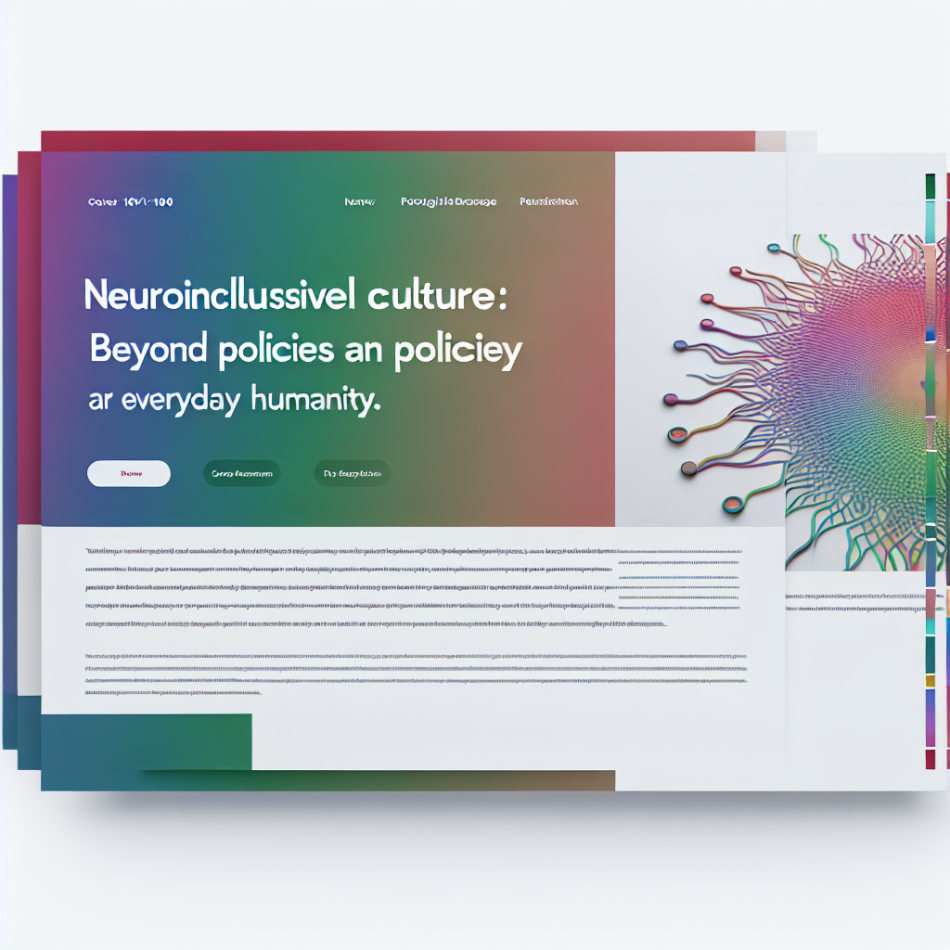Neuroinclusive Culture: Beyond Policies to Everyday Humanity
Neuroinclusive culture is not a checklist or a mandatory training module—it thrives in the unspoken moments of respect, empathy, and understanding between individuals. While policies provide structure, true inclusion happens when people authentically embrace neurodiversity in their daily interactions. This article explores how fostering such a culture relies less on formal frameworks and more on collective humanity, even when no one is monitoring compliance.
Defining Neuroinclusive Culture
A neuroinclusive culture recognises and values the unique ways individuals process information, communicate, and experience the world. It moves beyond accommodating visible differences to normalising diverse cognitive styles, whether related to autism, ADHD, dyslexia, or other neurodivergences. Crucially, it’s not about tolerating differences but celebrating them as assets that enrich teams, communities, and workplaces.
Traditional diversity initiatives often focus on compliance, such as adjusting physical spaces or mandating sensitivity training. While these steps matter, they risk becoming performative if not paired with a deeper cultural shift. Neuroinclusion requires dismantling the assumption that there’s a “correct” way to think, learn, or collaborate.
Neuroinclusion as an Organic Practice
Policies can outline expectations, but neuroinclusion lives in everyday actions. Consider a workplace where:
- A colleague quietly dims overhead lights without being asked, knowing a teammate is sensory-sensitive.
- Managers prioritise clear, written instructions alongside verbal briefings to reduce ambiguity.
- Team members normalise taking breaks during meetings without judgment.
These subtle gestures reflect a culture where inclusion is instinctive, not imposed. They require no oversight because they stem from genuine awareness and consideration.
The Role of Empathy and Education
Empathy fuels neuroinclusive behaviour, but it must be informed by education. Misconceptions about neurodivergence—such as equating autism with lack of emotion or ADHD with laziness—persist even in progressive spaces. Organisations must move beyond superficial awareness campaigns to deeper learning opportunities, such as:
- Workshops led by neurodivergent voices, sharing lived experiences.
- Training on intersectional challenges, like how neurodivergence interacts with race, gender, or socioeconomic barriers.
- Resources that equip teams to ask, “How can I support you?” rather than make assumptions.
When people understand the why behind inclusive actions, they’re more likely to adopt them authentically.
Leadership’s Role in Modelling Inclusion
Leaders set the tone for whether neuroinclusion remains a policy or becomes a practice. When executives openly discuss their own neurodivergence or prioritise flexible work arrangements, it signals psychological safety. Conversely, leaders who pay lip service to inclusion while rewarding rigid conformity undermine progress.
Effective leadership also involves:
- Encouraging feedback loops where neurodivergent individuals shape policies.
- Recognising and addressing microaggressions, like dismissing someone’s communication style as “unprofessional.”
- Allowing teams to customise workflows rather than enforcing one-size-fits-all processes.
Challenges and Misconceptions
One major barrier to neuroinclusive cultures is the myth that it’s solely a “neurodivergent issue.” In reality, inclusion benefits everyone. For instance, clear communication aids non-native speakers, and flexible deadlines reduce burnout across teams. Another challenge is conflating neuroinclusion with lowered standards. Accommodations like noise-cancelling headphones or task-management tools aren’t about special treatment—they’re about equitable access to productivity.
Additionally, neuroinclusion requires confronting unconscious biases. For example, extroverted norms in networking events may exclude those who thrive in one-on-one conversations. Addressing these biases demands ongoing reflection, not just initial training.
Sustaining Neuroinclusion Through Everyday Actions
Building a neuroinclusive culture is a continuous process, not a finite goal. Individuals contribute by:
- Practising active listening without interrupting.
- Offering multiple ways to participate in discussions (e.g., written feedback post-meeting).
- Respecting sensory needs, such as avoiding strong perfumes in shared spaces.
Organisations sustain inclusion by embedding it into systems, like incorporating neurodiversity into mentorship programmes or career development plans. Regular pulse surveys can identify gaps between policy and lived experience.
Conclusion: Inclusion as a Collective Commitment
Neuroinclusive culture flourishes when inclusion becomes a default mindset, not a compliance exercise. It’s found in the colleague who adjusts their communication style without prompting, the manager who values output over presenteeism, and the team that embraces diverse problem-solving approaches. Policies provide scaffolding, but lasting change happens through daily choices to prioritise dignity and belonging. Ultimately, neuroinclusion isn’t about perfection—it’s about progress, one intentional interaction at a time.
